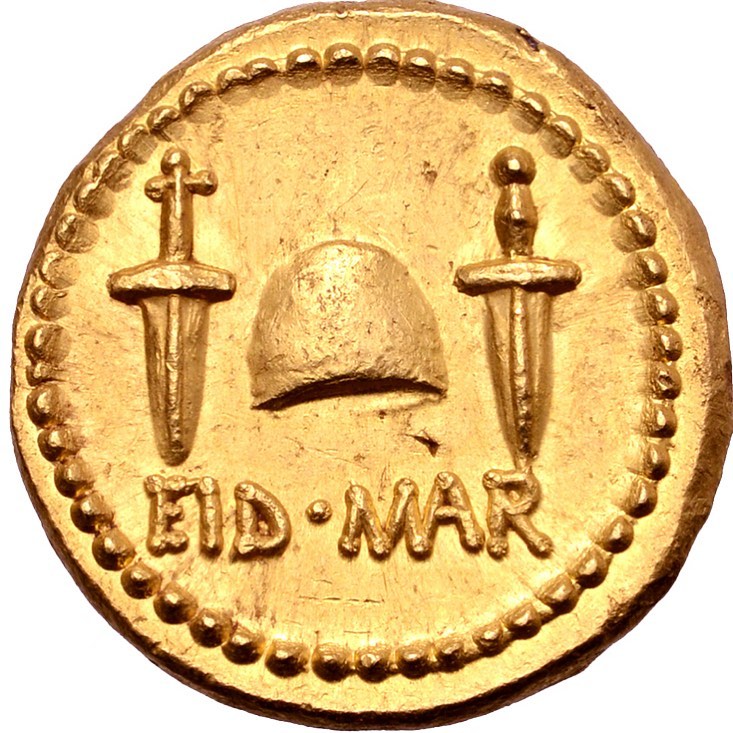The coin—minted by Brutus to pay tribute to the murder of Julius Caesar—was repatriated after an investigation found that it was sold through fake provenance in 2020.
Historical artifacts are certainly treasures worth acquiring, but the ethics behind their acquisition can be quite dubious. This was the case for an extremely rare gold coin minted by Roman politician Marcus Junius Brutus just two years after he orchestrated the death of Julius Caesar.
READ ALSO: A Japanese Icon: Katsushika Hokusai’s ‘Great Wave’ Print Sells For $2.8 Million
The piece, referred to as the “Eid Mar” coin, is only one of three in existence. It broke records in 2020 after being sold for $4.2 million through the London-based Roma Numismatics auction house—making it the most expensive coin in the world.

The unnamed American billionaire who bought the coin “in good faith” ended up surrendering it (along with 29 other Grecian artifacts) in February due to an investigation conducted by Homeland Security agents, which revealed that the coin was fraudulently sold.
Fortunately, the Eid Mar piece has returned to Greece, and the repatriation was marked by a ceremony held at the Greek Consulate in New York City. According to a statement released by Manhattan District Attorney Alvin L. Bragg, the surrendered Hellenic artifacts are said to date back as far as 5,000 BCE.
Today we announced the return of 29 looted antiquities worth over $20M+ to the People of Greece. Among the pieces was the extraordinarily rare Eid Mar Coin, which commemorates the murder of Julius Caesar. Learn more here: https://t.co/W1uwF7Xigb
— Alvin Bragg (@ManhattanDA) March 21, 2023
Questionable Acquisitions
Richard Beale, the auction house representative behind the fraudulent sale, was arrested last January for the crime. Reports say that Beale created fake records of ownership for the Eid Mar coin, as well as the “Sicily Naxos” coin—another rare piece sold at the 2020 auction. Beale’s records falsely stated that the coins came from the collection of “Baron Dominique de Chambrier,” so that the pieces would increase in value through provenance.
The Story of a Currency
The term “Eid Mar” translates to “Ides of March,” referring to the month of Caesar’s untimely demise in 44 BCE. When Brutus and his co-conspirators had fled Rome after the murder, the coin was minted in silver to pay his troops and in gold as a memento for high-ranking officials.

The rare coin is around the size of a nickel and weighs approximately eight grams, according to an article by The New York Times. A profile-portrait of Brutus is embossed in front of the coin, with the Latin letters “BRVT IMP” and “L PLAET CEST.” “BRVT IMP” is said to stand for “Brutus, Imperator” —referring to Brutus’ position as a commander. “L PLAET CEST” is supposed to be short for Lucius Plaetorius Cestianus, the name of Brutus’ treasurer who oversaw the minting process.
Meanwhile, the back of the coin features two daggers at the sides of a cap referred to as a pileus, as well as the “Eid Mar” inscription. The daggers are meant to represent the manner of Caesar’s death, while the pileus is a symbol of liberty, as it was often worn by freed slaves.

Other artifacts that were repatriated along with the coin include a 350 BCE funerary urn called the “Bronze Calyx Krater,” as well as 5,000-3,500 BCE marble figures of humans and animals called “Neolithic Family Group.” Sadly, the unethical acquisition of historical treasures is nothing new.
Ivan J. Arvelo, the Special Agent in Charge for Homeland Security Investigations in New York, shared the following in a recent statement: “Antiquities trafficking is a multi-billion-dollar business with looters and smugglers turning a profit at the expense of cultural heritage, and Greece—long acknowledged as the cradle of Western Civilization—is especially susceptible to this type of criminal enterprise.”
Banner Photo from Roma Numismatics Limited’s official website.

IL PRIMO ECOMMERCE SPECIALIZZATO IN DELIZIE AL TARTUFO E CAVIALE – CAVIAREAT.COM